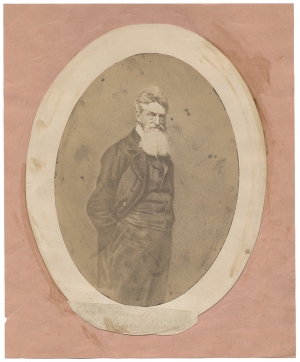|
Oval Salt Print of Famed Abolitionist John Brown |
Click to enlarge:

In May 1858, Martin M. Lawrence (1807-1859) took a photograph of John Brown at his studio at 381 Broadway in New York City, where he had worked as a daguerreotypist since 1842. He took it at the request of Dr. Thomas H. Webb (1801-1866) of Boston, Secretary of the New England Emigrant Aid Company. In November 1859, shortly before Brown’s execution, an engraving based on this photograph appeared on the cover of Frank Leslie’s Illustrated Newspaper.
[JOHN BROWN].
Oval Salt Print, with a printed signature,
“Your Friend, John Brown” affixed at bottom, ca. 1858-1859. No studio mark. 1 p., 5¼ x 7¼ in. oval on 7-x-9-in. mount affixed to a 9¾-x-11¾-in. scrapbook page.
Inventory #26463
SOLD — please inquire about other items
In May 1859, Boston photographer John B. Heywood made a negative for prints from the Lawrence daguerreotype. Photographer James W. Black (1825-1896) purchased Heywood’s studio and negatives in November 1859, and secured a copyright in December 1859, just weeks before Lawrence’s death. Studio-stamped prints by Black & Batchelder at 173 Washington St., Boston, regularly appear at auctions. The pasted signature on those reads, “Farewell God bless you John Brown.”
The salt print was the dominant paper-based photographic process for producing positive prints from 1839 through approximately 1860. English scientist and inventor Henry Fox Talbot (1800-1877) created the technique in the mid-1830s.
John Brown (1800-1859) was born in Connecticut but grew up in Ohio. At age 16, he studied in Connecticut to be a Congregationalist minister, but he ran out of money and had trouble with his eyes. He pursued various businesses in Pennsylvania and Ohio. After the death of Elijah P. Lovejoy at the hands of anti-abolitionists in 1837, Brown publicly vowed to “consecrate my life to the destruction of slavery!” Brown moved to Kansas in 1855, to help anti-slavery settlers protect themselves. That May, Brown and other abolitionist settlers killed five pro-slavery settlers. In November, Brown returned to the East and spent two years raising funds in New England and developing a plan for a direct strike against slavery. In October 1859, he led a group of 21 men to Harpers Ferry, Virginia, where they briefly seized the federal armory before local citizens trapped Brown and his men in a fire engine house before the arrival of U.S. Marines. Four of Brown’s men were killed, and he was wounded and captured along with the rest of his men. The commonwealth of Virginia tried and convicted Brown of murder, slave insurrection, and treason. He was executed on December 2. Six of his fellow raiders were executed later. The 1859 raid made him a martyr to the antislavery cause and was instrumental in heightening sectional animosities that led to the American Civil War.
Condition: Some scattered foxing and soiling on the image and the mount.
Known Lawrence Studio-stamped prints with “Your friend, John Brown” attached:
· Library of Congress, Washington, DC
· Herkimer County Historical Society, Herkimer, NY
· Kansas Historical Society, Topeka, KS
There are also “a few identical albumen salt prints with the same pasted facsimile signature but mounted without studio identification,” like the one offered here.[1]
[1]Jean Libby, “Timeline—The Bearded Portrait of John Brown”